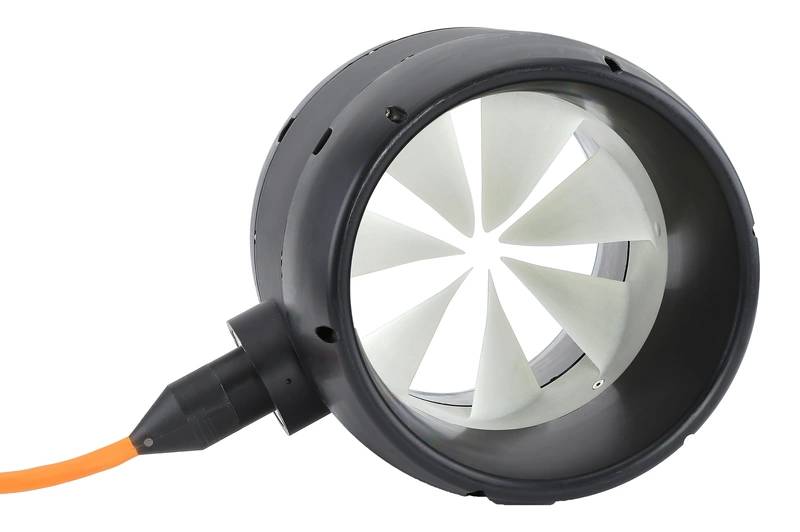Copenhagen Subsea Debuts the Gorilla ROV
Copenhagen Subsea launched a new powerful Remotely Operated Vehicle (ROV), specifically developed for the offshore industry. The ROV is based on Copenhagen Subsea’s rim-driven thruster technology and is designed to be robust and reliable in challenging environments – qualities which inspired us to name it the Gorilla.
In fact, reliability has been first and foremost throughout the design and development of the Gorilla. By basing the ROV on industrial components, Copenhagen Subsea was seeking to ensue the utmost operational reliability.
The Gorilla is equipped as standard with an intelligent Dynamic Positioning (DP) system, enabling automatic control of position, depth, altitude, heading, pitch and roll. A lack of thrusters is a common problem in conventional ROV design, which makes it impossible to control the pitch and roll of the vehicle and thus hard for the operator to keep it stable during operations. Even weak currents can cause some ROVs to tilt and the operator to lose control of the vehicle, potentially leading even to the abandonment of the mission and recovery of the ROV.
 The Gorilla ROV is based on Copenhagen Subsea’s Rim-driven thruster, technology which, combined with industrial electronics from Japan’s OMRON, gives a high level of reliability.Image: Copenhagen Subsea
The Gorilla ROV is based on Copenhagen Subsea’s Rim-driven thruster, technology which, combined with industrial electronics from Japan’s OMRON, gives a high level of reliability.Image: Copenhagen Subsea
By contrast, the Gorilla’s DP system makes it easy to operate the vehicle even in low visibility and strong currents. This is based on an advanced sensor system, which delivers input to the DP system to constantly adjust output of the ROV’s eight thrusters in a fly-by-wire system to keep it stable in the water. The Gorilla can sense the seafloor from up to 70 meters above, enabling the DP system to keep it in the required position, even should the operator take hands off the controls. This solves another common problem during launch of conventional ROVs, when the current can quickly push it away from the vessel, leaving the operator disoriented and without knowledge of its exact location or where to steer to reach its destination. This can often lead to an abandoned mission, necessitating a second attempt or a wait for conditions to improve. Instead, the Gorilla will use its DP system to instantly adjust the output of its eight thrusters to maintain position relative to the seabed, meaning the operator can easily steer to the designated destination. Copenhagen Subsea said the ROV can carry up to 70 kg and it has an easy to understand payload interface with a power supply and separate fiber cable connection, dedicated to the customer specific requirement.
The electrical system of the Gorilla ROV is based on industrial hardware from Japanese industrial electronics company OMRON, meaning that top to bottom Gorilla uses only industrial standard hardware components which are available commercially, a key differentiating factor in the reliability of the Gorilla. Industrial hardware components are cheaper, more reliable and easier to maintain as they are produced in series of hundreds of thousands and deployed worldwide across multiple industries. Such standard components are readily available off-the-shelf anywhere in the world and with significantly shorter delivery times for spare parts, compared to regular waits of 12 weeks or more for proprietary parts from conventional ROV manufacturers. Customers will have access to all electric documentation in the form of wiring diagrams, meaning they can service and maintain the vehicle on their own, as well as a full component list so they can source all parts directly. It means an operating company can simply change the Gorilla’s standard spare parts itself.
These robust industrial components are generally larger, but this means they have the required dimensions to perform reliably in extreme offshore conditions with extended temperature range. These parts also have the capacity to handle overload currents during acceleration and deacceleration and fast shifts of rotational direction. These elements are crucial to keep an ROV stable in challenging offshore conditions. Ideally suited for any task in short, the Gorilla is tough and strong, works reliably in challenging conditions, is simple to maintain with easy access spare parts and is easily controlled thanks to Copenhagen Subsea’s thruster technology.
www.copenhagensubsea.com
Read the Full Story in the March 2020 edition of Marine Tchnology Reporter: https://magazines.marinelink.com/nwm/MarineTechnology/202003/#page/52
 Allan Nygaard Bertelsen, CEO in Copenhagen Subsea
Allan Nygaard Bertelsen, CEO in Copenhagen Subsea
Other stories from February 2020 issue
Content
- Remotely Operated Vehicles: Thinking out of the Box page: 12
- Electric Motor Selection for Underwater Vehicles: Considerations of Partial Load Efficiency page: 18
- Environmental DNA Emerging in the Ocean Science Community page: 20
- Ocean Infinity’s Hunt for the Submarine San Juan page: 34
- MBARI Works at Unlocking Ocean Biology page: 42
- Copenhagen Subsea Debuts the Gorilla ROV page: 50

